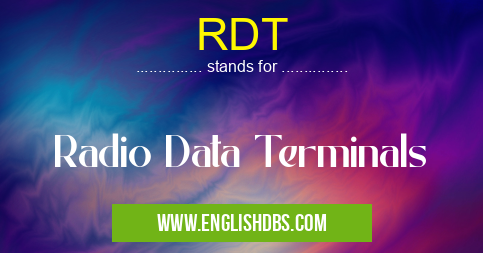What does RDT mean in UNCLASSIFIED
RDT (Radio Data Terminals) are wireless devices that facilitate data transmission and reception over radio networks. They provide a cost-effective and flexible solution for transmitting data in areas with limited or no wired infrastructure.

RDT meaning in Unclassified in Miscellaneous
RDT mostly used in an acronym Unclassified in Category Miscellaneous that means Radio Data Terminals
Shorthand: RDT,
Full Form: Radio Data Terminals
For more information of "Radio Data Terminals", see the section below.
RDT Functionality
RDTs operate by converting data into radio signals and transmitting them over radio channels. The receiving RDT demodulates the signals and recovers the original data. They typically use protocols such as Asynchronous Transfer Mode (ATM) or Internet Protocol (IP) to establish communication links.
Applications of RDTs
RDTs are widely used in various applications, including:
- Telemetry: Collecting and transmitting data from remote devices, such as sensors and actuators.
- SCADA (Supervisory Control and Data Acquisition): Monitoring and controlling industrial processes and equipment.
- Mobile data communication: Providing wireless internet access and data transmission in vehicles, trains, and ships.
- Asset tracking: Tracking the location and status of valuable assets, such as equipment and vehicles.
Features of RDTs
- Wireless connectivity: Enables data transmission over radio networks without the need for physical cables.
- Data compression: Reduces the size of data packets to optimize transmission efficiency.
- Error correction: Employs error detection and correction techniques to ensure data integrity.
- Low power consumption: Designed to operate for extended periods on battery power.
Essential Questions and Answers on Radio Data Terminals in "MISCELLANEOUS»UNFILED"
What are Radio Data Terminals (RDTs)?
Radio Data Terminals (RDTs) are wireless devices that allow data transmission and reception over radio frequencies. They are commonly used in industrial settings, military applications, and emergency response scenarios.
How do RDTs work?
RDTs employ radio waves to transmit and receive data. They utilize modulation techniques to encode digital information onto the radio carrier signal. The received signal is then demodulated to extract the data.
What are the advantages of using RDTs?
RDTs offer several advantages, including:
- Wireless connectivity: Enables data transmission and reception without the need for physical cables or wires.
- Robustness: RDTs are designed to withstand harsh environmental conditions, making them suitable for industrial and outdoor applications.
- Security: RDTs often employ encryption and other security measures to protect data from unauthorized access.
- Flexibility: RDTs are versatile devices that can be configured to suit specific communication requirements.
What are some applications of RDTs?
RDTs find applications in various industries, such as:
- Industrial automation: Monitoring and controlling machinery, processes, and equipment.
- Military communications: Secure data transmission and reception in tactical environments.
- Emergency response: Establishing communications during natural disasters or emergencies.
- Telemetry: Collecting and transmitting data from remote sensors or devices.
What are the different types of RDTs?
RDTs come in various types, including:
- Half-duplex RDTs: Allow data transmission in one direction at a time.
- Full-duplex RDTs: Enable simultaneous data transmission and reception.
- Narrowband RDTs: Utilize a limited frequency bandwidth for data transmission.
- Wideband RDTs: Support higher data rates by utilizing a wider frequency bandwidth.
How do I choose the right RDT for my application?
Selecting the appropriate RDT for your application requires consideration of factors such as:
- Data transmission rate: The speed at which data needs to be transmitted and received.
- Range: The distance over which data needs to be transmitted.
- Environmental conditions: The operating temperature, humidity, and potential presence of interference.
- Security requirements: The level of data protection needed.
- Compatibility: Ensuring compatibility with existing infrastructure and devices.
Final Words: RDTs play a crucial role in wireless data communication, providing a reliable and cost-effective solution for transmitting data in challenging environments. They are widely used in various applications, such as telemetry, SCADA, and mobile data communication, and are essential for enabling data connectivity in remote areas and mobile platforms.
RDT also stands for: |
|
| All stands for RDT |
